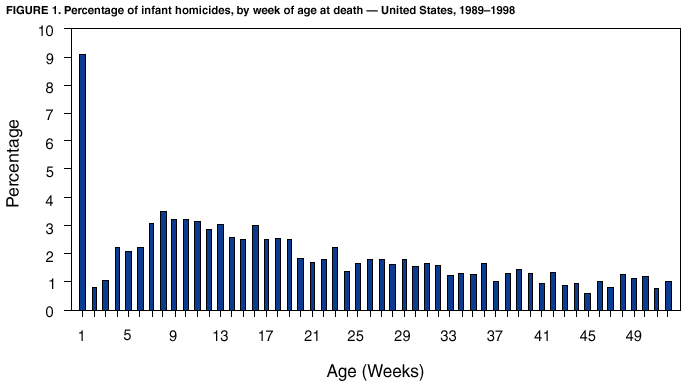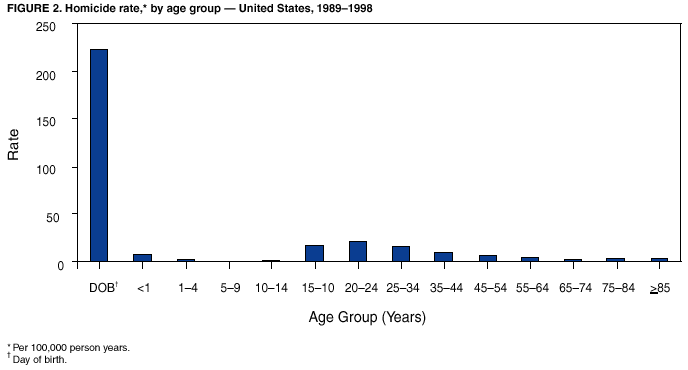 |
|
|
|
|
|
|
| ||||||||||
|
|
|
|
|
|
|
||||
| ||||||||||
|
|
|
|
|
Persons using assistive technology might not be able to fully access information in this file. For assistance, please send e-mail to: mmwrq@cdc.gov. Type 508 Accommodation and the title of the report in the subject line of e-mail. Variation in Homicide Risk During Infancy --- United States, 1989--1998Homicide is the 15th leading cause of death during the first year of life (i.e., infancy) in the United States. In addition, the risk for homicide is greater in infancy than in any other year of childhood before age 17 years (1) and is greatest during the first 4 months of life (2). To determine how the risk for homicide varied by week during infancy and by day during the first week of life, CDC analyzed death certificate data for 1989--1998. This report summarizes the results of this analysis, which indicated that risk for infant homicide is greatest on the day of birth. Efforts to prevent infant homicides should focus on early infancy. Most infant deaths are certified by medical examiners or coroners. Statistical information from death certificates is consolidated into a national database through the National Vital Statistics System (1). Information on U.S. resident infant homicide deaths for 1989--1998 was obtained from CDC's National Center for Health Statistics. An infant was defined as a person aged <1 year at death. Homicide was defined as an underlying cause coded through the International Classification of Disease, Ninth Revision, codes E960--E969 (3). Age at death in days was defined as one plus the difference between the dates of death and birth recorded on the death certificate. An infant killed on its date of birth had an age at death of 1 day. In comparison, homicide rates during different time periods within infancy were presented as rates per person-years of exposure. The U.S. infant population during 1989--1998 accounted for 39,941,628 person years of exposure, of which days of birth accounted for 109,354 person years, and the remainder of infancy accounted for 39,832,274 person years. During 1989--1998, a total of 3,312 infant homicides were reported for a rate of 8.3 per 100,000 person years. Of these, 81 (2.4%) were excluded because of a missing date of birth. The proportion of homicides occurring each week of infancy varied, with 9.1% of homicides occurring during the first week of life (Figure 1); a secondary peak in the distribution of homicides occurred at week 8. Among homicides during the first week of life, 82.6% occurred on the day of birth, 9.2% on the second day, and 8.2% during the remainder of the week. After the first 2 days of life, the number of deaths in the remainder of the first week was comparable to the number of deaths in the second week of life. Overall, 243 (7.3%) of all infant homicides occurred on the day of birth. When homicide rates on the first day of life and during the remainder of infancy were compared with homicide rates during later age groups (Figure 2), the homicide rate on the first day of life was at least ten times greater than the rate during any other time of life. Reported by: L Paulozzi, MD, Div of Violence Prevention, National Center for Injury Prevention and Control; M Sells, MS, Public Health Prevention Specialist Program, Div of Applied Public Health Training, Epidemiology Program Office, CDC. Editorial Note:The findings in this report highlight the high risk for homicide on the day of birth. Risk is comparatively small after the day of birth, even during the highest risk periods of adulthood. Among homicides on the first day of life, 95% of the victims are not born in a hospital. Among homicides later in infancy, 8% of infants are not born in a hospital (2). Among homicides during the first week of life, 89% of known perpetrators are female, usually the mother (4). Mothers who kill their infants are more likely to be adolescents and have a history of mental illness (2,5). The secondary peak in risk in week 8 might reflect the peak in the daily duration of crying among normal infants between weeks 6 and 8 (6). The limitations of these findings include the potential under and overascertainment of homicides through vital records. Infant homicides probably are underascertained by being either labeled as unintentional injuries or attributed to sudden infant death syndrome (SIDS) (7). Underascertainment probably does not vary by week of life and is unlikely to account for the observed pattern. Overascertainment might have occurred if some of the cases classified as homicides on the first day of life were actually stillbirths. It is not known what percent of cases of homicide on the day of birth might have been stillbirths. However, the percentage is probably small because medical examiners usually will attribute a death to infanticide only if autopsy evidence indicates that respiration had occurred, no evidence indicates death from natural causes, and circumstantial evidence is consistent with homicide (8). Preventing out-of-hospital births among high-risk women might help reduce the number of homicides on the day of birth. Home visitation and parenting programs, especially those that begin during pregnancy, might help reduce child abuse during infancy by focusing on the weeks of greatest risk early in infancy (9). References
Figure 1  Return to top. Figure 2  Return to top.
Disclaimer All MMWR HTML versions of articles are electronic conversions from ASCII text into HTML. This conversion may have resulted in character translation or format errors in the HTML version. Users should not rely on this HTML document, but are referred to the electronic PDF version and/or the original MMWR paper copy for the official text, figures, and tables. An original paper copy of this issue can be obtained from the Superintendent of Documents, U.S. Government Printing Office (GPO), Washington, DC 20402-9371; telephone: (202) 512-1800. Contact GPO for current prices. **Questions or messages regarding errors in formatting should be addressed to mmwrq@cdc.gov.Page converted: 3/7/2002 |
|||||||||
This page last reviewed 3/7/2002
|